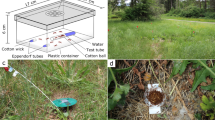Abstract
Glycoproteins on the body surface of females of the rotifer Brachionus plicatilis are a key signal in their mate recognition system. When B. plicatilis Russian strain females were exposed to 50 mM EDTA or EGTA, several surface glycoproteins were removed. Females exposed to EDTA died, but remained intact and were used in mating bioassays with conspecifics males. Live control females elicited a male mating response in 21% of encounters, freeze-killed control females elicited responses in 23%, but EDTA extracted females elicited a mating response in only 5% of encounters. At least some of the EDTA-extractable proteins on the surface of females appear to be critical to male mate recognition. EDTA treated females could be exposed to proteins extracted from other females and some proteins re-attached to their body surface, restoring their attractiveness to males. SDS-PAGE of these proteins revealed 15–17 prominent bands, most ranging in molecular mass from 66 to 12 kD. The EDTA-extractable proteins were separated using ion exchange chromatography and each fraction was tested for its ability to restore female attractiveness. When proteins in fraction 22 were bound to females, they restored 80% of the females’ ability to elicit male mating responses. Exposing EDTA treated females to bovine serum albumin or casein had no effect on their attractiveness to males. EDTA treated females from different Brachionus clades and species were exposed to proteins from fraction 22. Female attractiveness could be restored in most clades of B. plicatilis, but no transfer of mating attractiveness was observed to B. rotundiformis or B. ibericus females. Conspecific males treated with EDTA and exposed to proteins in fraction 22 could not be feminized and made attractive to other males. A sexual dimorphism in surface proteins therefore exists between B. plicatilis females and males. Successful transfer of glycoproteins critical in mate recognition is dependent on signal glycoprotein structure and the structure of the other proteins present on the surface of females.
Similar content being viewed by others
References
M. W. Blows R. A. Allan (1998) ArticleTitleLevels of mate recognition within and between two Drosophila species and their hybrids American Naturalist 152 826–837 Occurrence Handle10.1086/286211
Ciros-Perez A. Gómez M. Serra (2001) ArticleTitleOn the taxonomy of three sympatric species of the Brachionus plicatilis (Rotifera) complex from Spain, with the description of B. ibericus n. sp Journal of Plankton Research 23 1311–1328 Occurrence Handle10.1093/plankt/23.12.1311
J. A. Coyne B. Charlesworth (1997) Genetics of a pheromonal difference affecting sexual isolation between Drosophila mauritiana and D. sechellia Genetics 145 1015–1030
A. Derry P. D. N. Hebert E. E. Prepas (2003) ArticleTitleEvolution of rotifers in saline and subsaline lakes:a molecular genetic approach Limnology and Oceanography 48 675–685
W. J. Etges M. A. Ahrens (2001) ArticleTitlePremating isolation is determined by larval-rearing substrates in cactophilic Drosophila mojavensis. V. Deep geographic variation in epicuticular hydrocarbons among isolated populations American Naturalist 158 585–598 Occurrence Handle10.1086/323587
A. Gómez M. Serra (1995) ArticleTitleBehavioral reproductive isolation among sympatric strains of Brachionus plicatilis (Müller, 1786) insights into the status of this taxonomic species Hydrobiologia 313/314 111–119 Occurrence Handle10.1007/BF00025938
A. Gómez T.W. Snell (1996) ArticleTitleSibling species and cryptic speciation in the Brachionus plicatilis species complex (Rotifera) Journal of Evolutionary Biology 9 953–964 Occurrence Handle10.1046/j.1420-9101.1996.9060953.x
A. Gómez G. R. Carvalho (2000) ArticleTitleSex, parthenogenesis and the genetic structure of rotifers: microsatellite analysis of contemporary and resting egg bank populations Molecular Ecology 9 203–214 Occurrence Handle10.1046/j.1365-294x.2000.00849.x Occurrence Handle10672164
A. Gómez M. Serra G. R. Carvalho D. H. Lunt (2002) ArticleTitleSpeciation in ancient cryptic species complexes: evidence from the molecular phylogeny of Brachionus plicatilis (Rotifera) Evolution 56 1431–1444 Occurrence Handle12206243
K. Nomura N. Suzuki (1995) ArticleTitleSea-urchin ovoperoxidase-solubilization and isolation from the fertilization envelope,some structural and functional properties, and degradation by hatching enzyme Archives of Biochemistry and Biophysics 319 525–534 Occurrence Handle10.1006/abbi.1995.1327 Occurrence Handle7786038
R. Ortells T. W. Snell A. Gómez M. Serra. (2000) ArticleTitlePatterns of genetic differentiation in resting egg banks of a rotifer species complex in Spain Archiv für Hydrobiologie 149 529–551
H. Segers (1995) ArticleTitleNomenclatural consequences of some recent studies on Brachionus plicatilis (Rotifera, Brachionidae) Hydrobiologia 313/314 121–122 Occurrence Handle10.1007/BF00025939
M. Serra A. Galiana A. Gómez (1997) ArticleTitleSpeciation in monogonont rotifers Hydrobiologia 358 63–70 Occurrence Handle10.1023/A:1003155617297
M. Serra A. Gómez M. J. Carmona (1998) ArticleTitleEcological genetics of Brachionus sibling species Hydrobiologia 387/388 373–384 Occurrence Handle10.1023/A:1017083820908
T. W. Snell C. A. Hawkinson (1983) ArticleTitleBehavioral reproductive isolation among populations of the rotifer Brachionus plicatilis Evolution 37 1294–1305
T. W. Snell M. J. Childress B. C. Winkler (1988) ArticleTitleCharacteristics of the mate recognition factor in the rotifer Brachionus plicatilis Comparative Biochemistry and Physiology 89A 481–485
T. W. Snell (1989) ArticleTitleSystematics, reproductive isolation and species boundaries in monogonont rotifers Hydrobiologia 186/187 299–310 Occurrence Handle10.1007/BF00048925
T. W. Snell M. A. Nacionales (1990) ArticleTitleSex pheromone communication in Brachionus plicatilis (Rotifera) Comparative Biochemistry and Physiology 97A 211–216
Morris P. D. Snell T. W. (1993) ArticleTitleSexual communication in copepods and rotifers Hydrobiologia 255/256 109–116 Occurrence Handle10.1007/BF00025828
T. W. Snell P. D. Morris G. A. Cecchine (1993) ArticleTitleLocalization of the mate recogntion pheromone in Brachionus plicatilis (O.F. Müller) (Rotifera) by fluorescent labeling with lectins Journal of Experimental Marine Biology and Ecology 165 225–235 Occurrence Handle10.1016/0022-0981(93)90107-Y
T. W. Snell R. Rico-Martinez L. N. Kelly T. E. Battle (1995) ArticleTitleIdentification of a sex pheromone from a rotifer Marine Biology 123 347–353
T. W. Snell (1998) ArticleTitleChemical ecology of rotifers Hydrobiologia 387/388 267–276 Occurrence Handle10.1023/A:1017087003334
Ph.D. Dissertation
B. Ziola L. Gee N. N. Berg S. Y. Lee (2000) ArticleTitleSerogroups of the beer spoilage bacterium Megasphaera cerevisiae correlate with the molecular weight of the major EDTA-extractable surface protein Canadian Journal of Microbiology 46 95–100 Occurrence Handle10.1139/cjm-46-2-95 Occurrence Handle10721476
Author information
Authors and Affiliations
Corresponding author
Rights and permissions
About this article
Cite this article
Snell, T.W., Stelzer, CP. Removal of Surface Glycoproteins and Transfer among Brachionus species. Hydrobiologia 546, 267–274 (2005). https://doi.org/10.1007/s10750-005-4207-1
Accepted:
Issue Date:
DOI: https://doi.org/10.1007/s10750-005-4207-1




